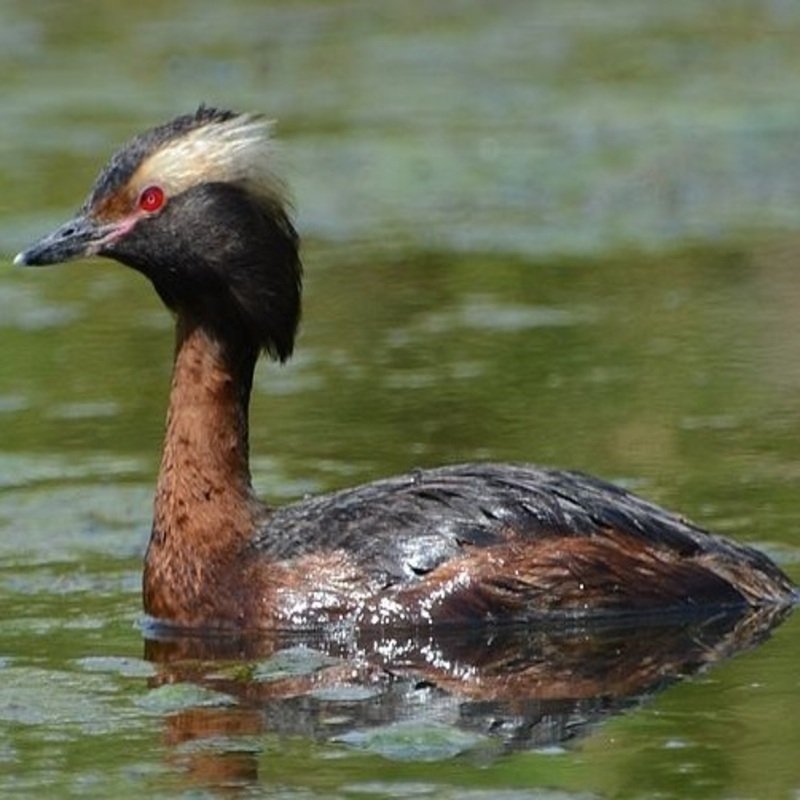Known as the horned grebe, Podiceps auritus is a tiny waterbird of the Podicipedidae family. It breeds in the Palearctic, whereas P. a. cornutus breeds in North America. The Eurasian subspecies breed from Greenland to western China. Canada and the United States are home to the North American subspecies. The birds’ “horns” are big yellowish patches of feathers behind their eyes that they can raise and lower at whim.
Quick Overview: Podiceps Auratus – Horned Grebe
Body size: Around12-15 in (30-38 cm) and weight of 453 g (16 oz)
Main colors: Crimson, Orange, Black, White,
Range: Throughout the United States
Migratory Bird: Yes
Best time of the year to see in the U.S.: January, February, December
Conservation Status: Least Concern
Horned Grebe Description
The horned grebe has a compact body and a pointed beak. 31-38 cm long, 300-570 g. They have a crimson neck, breast, and flanks. The back, neck, and head are all dark black. The species’ distinctive orange-buff to golden ear plumes set it apart from other grebes. Horned grebes have black bills and white breasts. The horned grebe’s winter plumage is dull. Face, neck, and breast are white; head, nape, and back are black.

Size
These birds have a length of 12-15 in (30-38 cm) and a weight of 453 g (16 oz). Their wings could range 24 in (61 cm).
Feeding
In the summer, horned grebes eat aquatic arthropods, and in the winter, fish and crabs. Leeches, tadpoles, salamanders, and plant debris are occasionally eaten. Mollusks are eaten at the wintering grounds. Horned grebes dive for their prey. They can consume little objects underwater but must bring huge ones to the surface to handle.
Habitat
Horned grebes nest in prairie and boreal freshwater lakes with open water and marsh vegetation. They nest in marshes, weedy sloughs, ponds, and rivers. These birds spend the winter in sheltered bays and exposed shorelines along the coast, as well as huge freshwater lakes.
Behavior
Horned grebes can swim and dive well. They can dive for up to three minutes and go 150-200 meters. They can also regulate their specific gravity to float higher in the water. Horned grebes are elegant on water but clumsy land. Their legs are so far back that they can hardly walk.
Podiceps Auratus Scientific Classification
- Kingdom: Animalia
- Phylum: Chordata
- Subphylum: Chelicerata
- Class: Aves
- Order: Podicipediformes
- Family: Podicipedidae
- Genus: Podiceps
- Species: Podiceps auritus
Best time of the year to see
The best time to see these birds in the United States is during the winter season (December to February).
Distribution of the Horned Grebe in the USA
From Alaska, and northern Canada to Washington, and the North Dakota and South Dakota this species breeds. Winters in the Aleutian Islands and along the Pacific Coast from Alaska to California, as well as along the Atlantic and Gulf Coasts from Florida to Texas.
The Horned Grebe can be found in the following states in the United States – Alabama, Alaska, Arizona, Arkansas, Colorado, Connecticut, Delaware, Georgia, Hawaii, Idaho, Illinois, Indiana, Iowa, Kansas, Kentucky, Louisiana, Maine, Maryland, Massachusetts, Michigan, Minnesota, Mississippi, Missouri, Montana, Nebraska, Nevada, New Hampshire, New Jersey, New Mexico, New York, North Carolina, Ohio, Oklahoma, Oregon, Pennsylvania, Rhode Island, South Carolina, Tennessee, Utah, Vermont, Virginia, West Virginia, Wisconsin and Wyoming.
